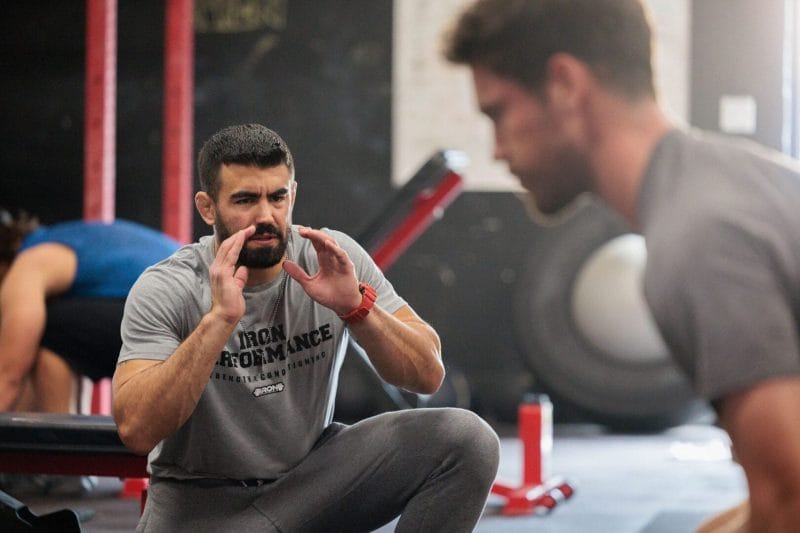As a facility in the private sector, we work with athletes and teams of various ages, sporting backgrounds, and levels. We train teams from the high school level up to the semi-professional; all of whom come to our relatively small facility for the best coaching in the region. In this scenario, facility size really doesn’t matter; it’s what you do with it that counts. It’s imperative to cater your plans around your space for efficient team lifts.
As coaches, we know it can be a challenge at times to implement efficient sessions. Balancing team needs with individual experiences while trying to stay within a certain time frame can certainly be a chaotic balancing act. Whether you’re a part of a full strength staff or a solo coach, I’m sure we could all agree that implementing efficient team or group sessions can feel like herding cats at times. We all aim to run a well-oiled weight room.
For us, we’ve found solace in implementing a variety of strategies to aid in our endeavors. To give you some context, our weight room is about 1400sqft with 3 power racks and some turf. While it may not sound like much, we’re able to effectively run group lifts of up to 15 athletes at one time (pre-covid days mind you). As coaches, we need to make sure our lifts are effective and completed in a timely manner. With a much smaller space than most, our staff devised 3 strategy pillars for our weight room to ensure our lifts ran like a well-oiled machine. Whether your weight room is large or small, the following strategies can help any coach worth their salt save time and run a more efficient lift.
GROUPING STRATEGIES
1) Group Athletes By Anthropometrics
A simple way to organize your team session is by grouping athletes by their height or limb length. Don’t make it harder than it has to be. Look at the team as a whole and break them up into pairs, threes, or whatever number you like by height. This alone will save time adjusting rack or bench heights and lead to a more efficient session.
We’ve found that athletes of similar builds tend to have similar limitations as well. If you find this to be the case, it can make programming and coaching modifications much easier.
2) Group Athletes By Position
We’ve found positional grouping to also be effective if working with a single sport. As positions have different roles, so to do the needs of athletes who fulfill them. If we look at baseball as an example, we may group our pitchers separate from our fielders. This can make programming more focused to the role needs while building positional competitiveness and comradery.
3) Group Athletes By Training Age
While grouping athletes based on seniority is popular, we should aim to look at training age. From our experience, we’ve found that there isn’t always a correlation with seniority to training age when planning sessions for our athletes. Some freshmen have 4 years of weight room experience heading into college while some seniors only have 4 years of weight room experience from college.
We’ve found this a more tricky strategy if trying to assimilate athletes of different biological ages if working with a single team. It just isn’t practical. However, you can group by training age within your levels of seniority (eg: more experienced freshmen grouped together). If working with multiple teams within a single session, this grouping may prove more effective for programming purposes.
PROGRAM STRATEGIES
1) Graded Training Plans
When catering to the masses, we can program our exercise series in tiers that we deem appropriate for different training ages and abilities. We like to use a simple color-coded system (green, yellow, red) to separate novices, intermediate and advanced athletes. For example, if we program total body power for our first exercise series, our beginners might do box jumps while our advanced athletes perform barbell snatches.
This can be useful to better individualize programs in an environment that typically accounts for the group. When implementing training age-graded plans, be sure to identify key metrics for separating tiers. This will make the progression or regression of athletes within tiers much smoother for future programs. It also keeps athletes competitive; everyone wants to be in the advanced tier. For more fun (and buy-in), you could base your tier hierarchy using your team’s mascot.
2) Positional Training Plans
If working with a single team of relatively similar training ages, positional training programs may work best. Program for positional roles to give the athletes that fulfill them what they need. Wide receivers have very different needs from linemen; your programs need to be able to account for positional demands. The positional strategy is rather simple; figure out the demands of the position and program accordingly. Period.
3) Element Training Plans
If working with multiple athletes of similar training ages from different sport teams in a single session, we’ve found sport element considerations to be effective in our programming. This requires a deeper understanding of each sport you’re working with, especially from a physics perspective. We’ll design programs based on force or elements of movement.
For example, football, rugby, and wrestling are high-impact collision sports so we might have those athletes on the same training plan (we call them Infantry). Baseball and golf are no impact sports so those athletes might be programmed together (we call them Artillery). If our session calls for a lower-body explosive exercise series, our Infantry might perform hang cleans while our Artillery do box jumps.
You can also program your athletes based on their sport movement elements. Simply modify the positional strategy; you now have athletes of different sport roles chasing a common goal. Volleyball and basketball are both vertical jump sports, we may decide to program them together as we look to increase height. You might program javelin with baseball as they’re both rotational; aim to throw hard and fast. How you decide which element takes priority is up to you, we’ve found both approaches to be effective.
SESSION STRATEGIES
1) Timed Intervals
During the training session, it can be a challenge to keep everyone on track. For those with smaller weight rooms, having athletes rotate stations in a timely fashion can be crucial for ensuring everyone gets a quality lift in. If not properly prepared, you’ll find yourself with confused athletes, frustrated staff, and an irritated AD.
A simple strategy we’ve found useful for efficiency is using timed intervals for our exercise series. Set a clock with an alarm for each tier of your program. The length of your intervals will depend on how long you feel each exercise series may take. A general guideline is anywhere from 10-15min per series. Once the clock goes off, athletes will proceed to the next series or rotate to the next station. Be sure to keep a close eye on the progress of your athletes throughout the intervals so as to better adjust future time points.
If cued correctly, this strategy can be very effective in ensuring time-sensitive high-quality lifts. Encourage athletes to get their sets done (with proper rest) within the time period. This will help drive competitiveness while keeping athletes focused on the work at hand; the bar should never get cold. To keep athletes on track when resting, we program less intensive remedial exercises in every tier.
2) Stations & Quadrants
This is pretty much just setting up stations for certain exercise series to be performed at. If you have a larger weight room with more equipment, every pair (or group) of athletes may be able to have their entire lift programmed at their own station. For those with less equipment, it might be worthwhile setting up stations (or quadrants) designed to be completed for each tier of your program. This is useful if working with athletes from different teams all following different programs.
For example, we have 3 power racks with options to do barbell work on the inside and outside. If working with a group following different programs, we’ll set up stations based on major movements or exercises. The inside of our racks will be squat stations while the outside will be used for pressing (vertical or horizontal). The floor space is where we set up our O-lift platforms or space for hinge patterns (deadlifts, RDLs’ etc.). We designate any remaining space for warm-up or remedial paired exercises.
In order for this to be an efficient strategy, you must be in tune with your programming and be able to foster independence with your athletes. As equipment is limited, it isn’t uncommon to see athletes bunch up at similar stations and waste time waiting for their turn. Encourage athletes to proceed to their next tier and come back when they’ve finished. In most cases, it’s another compound exercise anyways. Having an upper-lower split or total body program with optimal exercise order makes this much easier to implement.
IN CLOSING
It doesn’t matter the size of your weight room or staff, what matters is how you run it. These strategies have made our jobs here at Iron Performance Center much easier; we can run timely sessions while implementing (and coaching) optimal training plans. At the end of the day, get ‘em fast, get ‘em strong, ensure they’re able to last long.
Struggling to take your game to the next level? Our staff have tons of experience working with the best athletes across the country. Click here to schedule a call with us and see if we’re a good fit!


